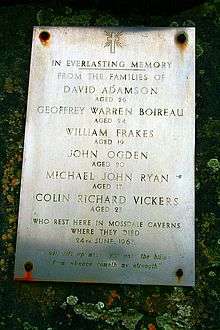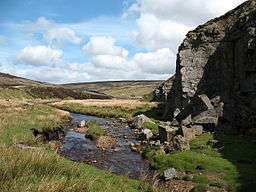Mossdale Caverns
| Mossdale Caverns | |
|---|---|
|
Mossdale Scar | |
| Location | Yorkshire Dales |
| Coordinates | 54°07′25″N 1°58′36″W / 54.12361°N 1.97667°W |
| Depth | 76 m (249 ft) |
| Length | 10.5 km (6.5 mi) |
| Discovery | 1941 |
| Geology | Carboniferous limestone |
| Entrances | 1 |
| Difficulty | Grade 5 |
| Hazards | Flooding |
| Access | not granted |
| Cave survey | Online ULSA survey |
Mossdale Caverns is a cave system in the Yorkshire Dales, England. It is located about 5 kilometres (3.1 mi) north of Grassington, and east of Conistone, where Mossdale Beck sinks at the base of Mossdale Scar. It lies at an altitude of 425 metres (1,394 ft) on the eastern flank of Wharfedale, and extends south-east beneath Grassington Moor.
The cave system is formed within the Middle Limestone of the Yoredale Series.[1] The large stream (average flow 100 litres/second) has been shown by dye testing to resurge at Black Keld, some 4.4 kilometres (2.7 mi) to the WNW 225 metres (738 ft) lower.[2]
Speleology
Exploration of Mossdale Caverns was begun in 1941 by Bob Leakey of the British Speleological Association. It is a very flood-prone challenging cave system, with many of its passages involving long wet crawls. Other sections have neck-deep water and many of Leakey's explorations were conducted solo as few of his contemporaries had the necessary endurance. The end was finally reached again in 1964 by Mike Boone and Pete Livesey.[3] A return trip to the far end takes between eight and ten hours.[4]
Permission to enter the caves is no longer granted because of the tragedy that occurred in 1967. Exploration does still take place, but on an unofficial basis. It is thought that the cave system may hold the key to breaking into the Great Scar Limestone and the extensive cave that exists behind Black Keld.
1967 tragedy

The cave system is notorious amongst cavers in the United Kingdom for a tragedy that occurred on 24 June 1967. On that day, ten cavers entered the system. Three hours later, four members of the party decided not to continue and exited the cave system. One of these four returned to the entrance shortly afterwards, only to find it completely submerged due to recent rainfall having swollen Mossdale Beck. Realising immediately that the six cavers who remained inside the cave system were in danger, she ran 4 kilometres (2.5 mi) across the moor to raise the alarm.
Cave Rescue teams arrived at the scene, but the high water levels prevented access to the cave. The waters of Mossdale beck had to be diverted away from the cave entrance by digging a trench. Even then the rescue operation could not be started because of the high internal water levels.
It was not until the following day that entry was possible. The cave rescue teams found the bodies of five of the cavers in the Far Marathon Crawls, and Bob Leakey led a search party to a location where he believed the sixth might have survived, but without success.[5] The sixth was located the following day. The bodies were left in situ. The coroner decided to seal the cave, and concrete was poured down the only safe entrance. This was later re-opened and in 1971, with the agreement of their families, the bodies were buried by their colleagues from the ULSA in "Mud Caverns", a chamber at the far end of the system.[6]
This is to date the most deadly incident in British caving. A memorial plaque is affixed to the cliff above the entrance.
On the moors above is a memorial cairn. The plaque on the cairn reads: Mossdale memorial cairn – over the place in the cave where the bodies were found.
There is a rock climbing route "Mossdale Trip" (E6 6b)[7] that was named in remembrance of the tragedy by Pete Livesey.
References
- ↑ Tony Waltham and David Lowe, ed. (2013). Caves and Karst of the Yorkshire Dales. British Cave Research Association. p. 22. ISBN 978-0-900265-46-4.
- ↑ Myers, J.O. (1950). "The Mossdale Problem. The Problem of the Underground Water Flow". Transaction of the Cave Research Group. 1 (4): 21–30.
- ↑ Boone, J.M. (1977). Down to a Sunless Sea. Edmonton: The Stalactite Press. pp. 31–47.
- ↑ Cooper, Mike (2006). Not for the Faint-Hearted. Hebden Bridge: Purprise Press. pp. 42–46. ISBN 978-0-9554139-0-2.
- ↑ "Obituaries: Bob Leakey". Daily Telegraph. 3 May 2013. Retrieved 7 May 2013.
- ↑ Brook, Dave (July 1971). "Mossdale Caverns 1971". University of Leeds Speleological Association Review (8): 24, 25.
- ↑ http://www.ukclimbing.com/logbook/c.php?i=12740
External links
- Googlemap showing location of the cave entrance
- Pictures of the memorial cairn
- An interview on the British Cave Research Association library website with Bob Leakey where he discusses his original Mossdale Caverns explorations]
- What lies beneath - The Mossdale caving disaster, Roy Kershaw, The Independent Magazine, 15 March 2008, pp. 29–32
- An interview with Jack Pickup about the tragedy on the British Cave Research Association library website
Coordinates: 54°07′25″N 1°58′36″W / 54.12361°N 1.97667°W
